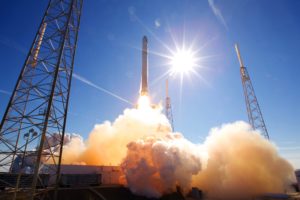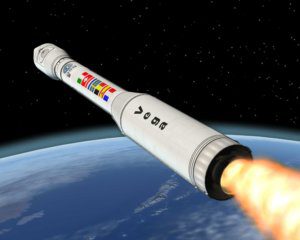
The European light launch vehicle (LV) Vega with a Ukrainian engine has successfully placed in orbit Italy’s Earth remote sensing satellite PRISMA.
According to the press release of the Pivdenne (Yuzhnoye) Design Bureau, the satellite aboard Vega LV lifted off the European spaceport of Kourou (French Guiana) at 0350 on March 22, 2019. This was the fourteenth launch under the Vega program and the first in 2019.
PRISMA spacecraft with 879 kg weight is a small satellite of the Italian Space Agency (ASI). PRISMA is equipped with an innovative electro-optical instrumentation. The instrument is able to work in numerous, narrow and contiguous bands arranged from the visible to the near infrared (VNIR, Visible and Near InfraRed) and up to the infrared shortwave (SWIR, Short Wave InfraRed). The mission will help in monitoring agricultural activities, water resources and studying main environmental processes. PRISMA began a five-year operational mission.
The Vega was developed by the European Space Agency (ESA) in cooperation with the Italian Space Agency (ASI). It is intended for launching into a solar-synchronous orbit with a height of 1,200 km satellites weighing up to 1,200 kg or into a polar orbit with a height of 700 km satellites weighing up to 1,500 kg.
The propulsion engine for the 4th stage of the PH RD-868P was developed by the Yuzhnoye Design Bureau and manufactured the Yuzhmash PO (both from Dnipro, Ukraine). According to the developer, the new liquid engine is based on the intercontinental ballistic missile carrier (ICBM) RS-20.
A successful test run of the Vega rocket was carried out in February 2012. Since May 2013, ESA has begun commercial operation of the new launch vehicle. Some 30 satellites have been launched into orbit for customers.
In July 2017, Ukrainian participants in the Vega program cooperation extended the contract signed in 2012 with a European contractor – Italian Avio SpA – for the supply of production engines for the Vega rocket until 2020.
The government of Ukraine and the ESA signed an agreement on cooperation in the peaceful uses of outer space in 2008.
The structure of the ESA includes 17 European countries.
Ukraine is currently preparing the creation of an information hub for the implementation of the cooperation agreement with the EU signed in May 2018 in the European space monitoring program Copernicus.

Vega, a large Ukrainian telecoms operator, in 2018 received UAH 641.3 million of net income, which is 3.79% more than in 2017, the company has reported.
According to the operator’s press release, EBITDA reached UAH 164.9 million, which is 49% more than last year. Also, in 2018, the company managed to increase ARPU (the average revenue per user) by 20%, in particular, Internet access services using the FTTx connection technology by 28%.
During the reporting period, the subscriber base of Vega, as compared with 2017, increased in Voice VoIP (Voice over Internet Protocol) by more than 10%.
“Last year, we strictly followed the given strategic vector associated with the transition to modern services. This year, the company will continue to actively modernize its networks: replacing copper with optics, and digitizing its business, introducing new services based on digital technologies,” Vega CEO Murat Chynar said.
In 2018, the company’s capital investments remained at the level of 2017 and amounted to UAH 97.4 million.

Vega, the largest Ukrainian telecoms operator, in January-September 2018 saw EBITDA rise by 43%, to UAH 127 million, the company’s net income amounted to UAH 469 million, which is 4% more than in the same period of 2017.
At the same time, the company did not provide information on the company’s net profit/loss for the first half of the year.
According to the operator’s press release, the positive dynamics of the company’s revenues is related to the growth in revenues from the provision of services by fiber-optic channels and from IP services. The revenue in the key business sector of the company is also constantly growing.
In the first nine months of this year, Vega invested UAH 60 million in the development of its own networks and modernization against UAH 66.8 million in the nine months of 2017.
The company also noted that the share of IP telephony clients (VoIP) in the B2B base of subscribers of telephony services increased by 21% compared to the same period last year.
At the same time, the average revenue per user (ARPU) for the above mentioned period rose by 18.4% due to the growing share of the business segment in the subscriber base and the increasing popularity of high yield products.
The volume of taxes and fees the company paid to the budgets of various levels in January-September amounted to UAH 104 million, which is 20% more than last year.

A European Vega light launch vehicle, which has a Ukrainian-made engine, has successfully put the European Space Agency’s Earth Explorer Aeolus satellite into orbit.
The Vega rocket lifted away at 00:20 Kyiv time on August 23 from the Guiana Space Centre to the northwest of Kourou in French Guiana, France (South America), the State Space Agency of Ukraine (SSAU) said on its website. It was the twelfth launch under the Vega program and the first one this year.
Built by the European concern Airbus, the Aeolus satellite weighs 1.35 tonnes and is designed for long-range wind-mapping, it will probe the atmosphere with pioneering ultraviolet laser pulses. It is the first satellite that is able to measure wind speeds, using a laser technology for creating dynamic 3D maps of the earth’s surface winds. Aeolus is equipped with a Light Detection and Ranging (LIDAR) instrument called Aladin, which uses the Doppler effect for determining wind speeds at various altitudes. The satellite is to provide reliable information about global wind conditions. The information is necessary for meteorologists to make better forecasts and for climatologists to enhance the understanding of tropical dynamics and processes relevant to climate variability. The satellite will operate for three years.
The Vega launch vehicle was developed by ESA together the Italian Space Agency (ASI). It is designed to launch small payloads. The launcher is capable of delivering a reference payload mass of up to 1,500 kg into a circular sun-synchronous orbit of 700 km altitude.
The RD-848P engine for the fourth stage of the rocket was developed by Ukraine’s state-owned Pivdenne Design Bureau (Dnipro) and manufactured by Dnipro-based state-owned Pivdenmash. The first successful launch was in February 2012. From May 2013, ESA began using a new launch vehicle on a commercial basis.
In July 2017, Ukrainian participants in the Vega program extended the contract signed in 2012 with the European subcontractor, Avio SpA, for deliveries of engines for the Vega launch vehicle through 2020.
Ukraine’s government and ESA signed a cooperation agreement concerning space cooperation for peaceful purposes in 2008. Some 17 European countries are ESA members.
Ukraine is currently preparing to create an information hub in accordance with a contract signed in May 2018 with the EU on cooperation in the Copernicus Earth observation program.
EARTH EXPLORER AEOLUS, ESA'S, ORBIT, SATELLITE, UKRAINIAN ENGINE, VEGA